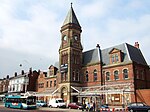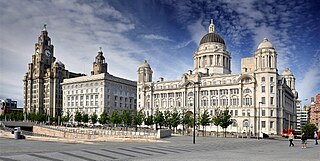
Merseyside is a ceremonial and metropolitan county in North West England. It borders Lancashire to the north, Greater Manchester to the east, Cheshire to the south, the Welsh county of Flintshire across the Dee Estuary to the southwest, and the Irish Sea to the west. The largest settlement is the city of Liverpool.

Merseyrail is a commuter rail network which serves Merseyside and adjacent areas of Cheshire and Lancashire. Merseyrail serves 69 stations, 67 of which it manages, across two lines – the Northern Line and the Wirral Line. The network uses 750 V DC third rail electrified lines having 75.0 miles (120.7 km) of routes, of which 6.5 miles (10.5 km) are underground. Since January 2023, Merseyrail commenced replacing its train fleet, withdrawing the Class 507 and 508 trains and introducing 53 new Class 777 trains. The network carried 25.5 million passengers in the 2022/2023 statistical period.
Merseytravel is the passenger transport executive, responsible for the coordination of public transport in the Liverpool City Region in North West England. Merseytravel was established on 1 December 1969 as the Merseyside Passenger Transport Executive. From 1 April 2014, with the creation of the Liverpool City Region, Merseytravel expanded its area of operation from the metropolitan county of Merseyside to also include the Borough of Halton.
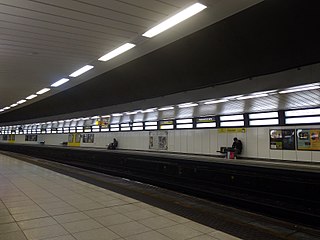
Birkenhead Hamilton Square railway station serves the town of Birkenhead, in Merseyside, England, on the Wirral Line of the Merseyrail network. The station is close to Hamilton Square in Birkenhead.

The Wirral line is one of two commuter rail routes operated by Merseyrail and centred on Merseyside, England, the other being the Northern line.

The Chester–Birkenhead line runs from Chester to Birkenhead via Hooton. Today, it forms part of the Wirral Line network, a commuter rail system operated by Merseyrail. The line was built by the Chester and Birkenhead Railway and opened on 23 September 1840. On 22 July 1847 the railway merged with the Birkenhead, Lancashire and Cheshire Junction Railway which was later renamed to Birkenhead Railway.

West Kirby railway station serves the town of West Kirby in Merseyside, England. The station is the terminus of the West Kirby branch line, which is one of the two branches of the Wirral Line on the Merseyrail network. There is a central island platform between two terminus tracks and two parallel sidings for out-of-use electric multiple units. A second station, which was the terminus of a branch line from Hooton, lay to the east of the Wirral Line station; it was closed in 1962.

Bidston railway station serves the village of Bidston, Merseyside, England. The station is situated at a junction of the West Kirby branch of the Wirral line, which is part of the Merseyrail network; it also serves as the northern terminus for the Borderlands line from Wrexham Central, with services operated by Transport for Wales.

New Brighton railway station serves the suburb of New Brighton in Wallasey, Merseyside, England. It is situated at the end of the New Brighton branch of the Wirral Line 8.25 miles (13.28 km) west of Liverpool Lime Street on the Merseyrail network.
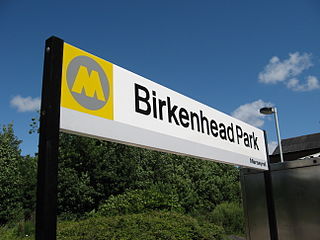
Birkenhead Park railway station is a station serving the town of Birkenhead, in Merseyside, England. It lies on the Wirral Line of the Merseyrail network.

Birkenhead North railway station serves the town of Birkenhead, in Merseyside, England. The station is situated on the Wirral Line of the Merseyrail network, close to the junction of the New Brighton and West Kirby branches. Birkenhead North TMD, situated just to the west of the station, is the main traction maintenance depot for the Merseyrail fleet.

Hooton railway station is situated in the south of the Wirral Peninsula, Cheshire, England. It lies on the Wirral Line 8 miles (13 km) north of Chester and 9+1⁄2 miles (15.3 km) south west of Liverpool Lime Street on the Merseyrail network, and is the junction of the branch from the Chester line to Ellesmere Port. It serves the villages of Hooton and Willaston.

Woodside is an area of Birkenhead in the Metropolitan Borough of Wirral in Merseyside, England. It is situated opposite Liverpool Pier Head across the River Mersey.

Ellesmere Port railway station is located in the town of Ellesmere Port, Cheshire, England. The station was an intermediate through station on the Hooton–Helsby line. Now all passenger services terminate at the station from both directions. It is both a terminus of the Wirral Line, a commuter rail system operated by Merseyrail and of Northern Trains services to Warrington Bank Quay. Departures and arrivals of Merseyrail services are on platform 1 with departures and arrivals to Warrington Bank Quay on platform 2.
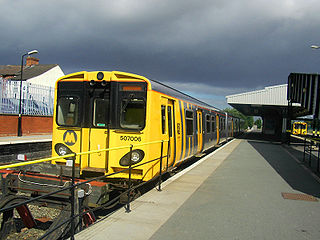
Rock Ferry railway station is situated in the Rock Ferry area of Birkenhead, Merseyside, England. The station lies 4.5 miles (7 km) south west of Liverpool Lime Street on the Chester and Ellesmere Port branches of the Wirral Line of the Merseyrail network. The station has an island platform with four platforms in total and four tracks.

Bebington railway station serves the town of Bebington in Merseyside, England. The station is situated on the Chester and Ellesmere Port branches of the Wirral Line, forming part of the Merseyrail network.

Birkenhead Town railway station is a disused railway station in Birkenhead, Wirral, England. It was located near the current entrance to the Queensway Tunnel on Grange Road.

Birkenhead Monks Ferry railway station was a railway station in Birkenhead, Wirral, England. It was situated very close to the River Mersey named after the monks at Birkenhead Priory. For most of its life, the station was part of the Chester and Birkenhead Railway, a joint railway.

Birkenhead Dock Branch is a disused railway line running from the South junction of Rock Ferry, to the site of the former Bidston Dock on the Wirral Peninsula, England. The branch is approximately 4+1⁄2 miles (7.2 km) in length. Although called a branch, the line was accessible from both ends, from Bidston East junction and from Rock Ferry railway station. The former Mollington Street Rail Depot was branched into the line. A section of the line runs through Haymarket Tunnel and a low-level cutting through the centre of Birkenhead; visible from the road flyovers. The former Canning Street North signal box has now been demolished following fire damage, and the rails across the level crossing there have been removed due to the provision of cycle lanes on the roadway. The non-standard gates remain on the east side, but a fence has been erected on the other side despite the railway being officially out of use, rather than closed. Level crossings are also located at Duke Street and Wallasey Bridge Road. The railway lines are still partially intact.

The Birkenhead Railway was a railway company in North West England. It was incorporated as the Birkenhead, Lancashire and Cheshire Junction Railway (BL&CJR) in 1846 to build a line connecting the port of Birkenhead and the city of Chester with the manufacturing districts of Lancashire by making a junction near Warrington with the Grand Junction Railway. The BL&CJR took over the Chester and Birkenhead Railway in 1847, keeping its own name for the combined company until it shortened its name to the Birkenhead Railway in 1859. It was taken over jointly, on 1 January 1860, by the London and North Western Railway (LNWR) and the Great Western Railway (GWR). It remained a joint railway until nationalisation of the railways in 1948.
























